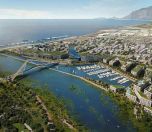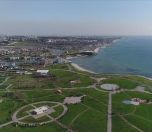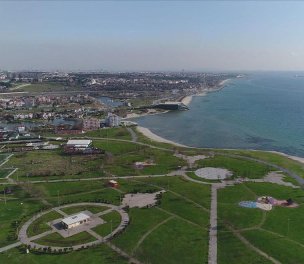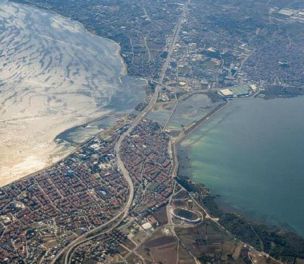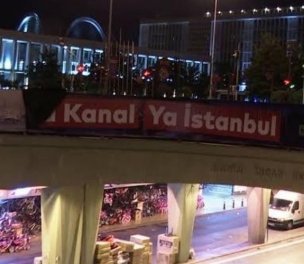* Photo: Anadolu Agency (AA) - Archive
Click to read the article in Turkish
The Ministry of Environment and Urbanization and the Ministry of Transport and Infrastructure have completed their joint works on the legislation that will be adopted in undertaking the Canal İstanbul project.
According to the draft legislation, the project will be carried out by adopting a build-operate-transfer model.
As reported by Ayşegül Kahvecioğlu from Milliyet, the companies that won the tender for the construction of the canal will be exempt from taxes for technical equipments of every kind that they will use in the construction. The revenue that they earn will be an exception to the corporate tax.
The forest lands falling within the Canal İstanbul project site will lose their quality of being forest lands.
Construction will take 7 years to complete
While the construction is expected to take 7 years, the cost of construction is estimated to be 75 billion Turkish Lira (TRY), which is approximately 10 billion US dollars. When completed, it is expected to bring a total revenue of 182 billion TRY (~25 billion USD) in the first 20 years.
"The Institutional Financial Standing and Outlook Report" prepared by the Ministry of Environment for 2020 says that the related works for the project are ready, adding that "with Canal İstanbul project, it is aimed to make İstanbul a 'World Brand' among international metropolitan cities by creating a healthy and safe living space that will prove environmentally-friendly, protect the ancient values and eliminate the disaster risk..."
The report has also noted that "a horizontal architectural style will be adopted" in undertaking the Canal İstanbul Project.
45-kilometer length
According to these works, Canal İstanbul project will be constructed along a route from Lake Küçükçekmece in the southern part of İstanbul through first Sazlıdere Dam, then to Terkos in northern İstanbul.
While the length of the project is estimated to be 45 kilometers, its base-width will be 275 meters and depth 20.75 meters.
Latest developments about the project
Tender won by Rönesans Group
The tender lodged by the Ministry of Transport and Infrastructure Directorate General of Highways for constructing the "Northern Marmara Highway (including 3rd Bosphorus Bridge) Project Nakkaş-Başakşehir (including link roads) section" with build-operate-transfer model is won by Rönesans Group, which also undertook the construction of Presidential Complex in Ankara.
Afterwards, it has been understood that these roads are the roads of "New City" (Yenişehir) which will be constructed as part of Canal İstanbul.
Nadir Ataman, an İstanbul Metropolitan Municipal Council member from the main opposition Republican People's Party (CHP), has said, "With the road tender lodged with the model of build-operate-transfer, it is seen that citizens will pay even to see the Canal İstanbul New City."
Drinking water basin zoned for construction
According to the 3rd stage plans of Canal İstanbul project covering 10 villages, Sazlıdere Dam, which partly meets İstanbulites' water needs, will be completely destroyed as it will be a part of the canal.
With these plans, the drinking water basins around the dam will also be zoned for construction. It is understood that when plans were still pending evaluation and objection, annotations were put on the title deeds of citizens.
The plans also foresee the construction of buildings with "a ground floor + 3 floors" around Canal İstanbul.
İt is also seen that no solutions have been developed to save the Şahintepe - Yarımburgaz Cave, where the first settled life started in the region 400 thousand years ago. In the current situation, Yarımburgaz Caves might be destroyed as a result of the project.
The 3rd stage plans of the project cover an area of 5 thousand 893 hectares and 10 villages, namely Çilingir, Dursunköy, Hacımaşlı, Hadımköy, Haraççı, Sazlıbosna, Güvercintepe, Kayabaşı, Şahintepe and Şamlar.
The village settlements it Hacımaşlı, Sazlıbosna and Çilingir and agricultural fields in Dursunköy and Şamlar are also a part of the plan.
An agricultural field of 10 thousand hectares will be lost
With these plans, several agricultural fields, pasturelands and several other sites have been zoned for construction. While a road is to be build on Çilingir Village Cemetery, the villages on the route of Canal İstanbul project have been completely changed with the new plans.
According to the data of the İstanbul Metropolitan Municipality, when the 1 to 100,000 Scale Environmental Plan for İstanbul dated 2009 is examined, it is seen that the total amount of agricultural land was 11 thousand 218 hectares.
However, when the plan change as to Canal İstanbul in 2020 is examined, this figure drops to 733 hectares. In other words, an agricultural field of 10 thousand 485 hectares will be lost as a result of the project.
In the plan dated 2009, the total amount of forestland was indicated as 2 thousand 984 hectares; but, when the plan change dated 2020 is examined, it is seen that this figure also drops to 2 thousand 134 hectares. So, with Canal İstanbul project, a forestland of 850 hectares will be lost.
As for pasturelands, it will drop from its former amount of 497 hectares to zero (0) in 2020. That being the case, the villagers living in the region will no longer have lands to graze their animals when the project is completed.
While the planned land in the project site was 12 thousand 509 hectares, it has increased to 35 thousand 714 hectares after Canal İstanbul project, which will lead to construction in and around the project site.
While an area of 2 thousand 526 hectares is now open to construction in the region, this figure has reached 9 thousand 446 hectares with the project.
It foresees 1.2 million additional population to come to the city.
Canal İstanbul project
PPresident and ruling Justice and Development Party (AKP) Chair Recep Tayyip Erdoğan made a statement in 2011, when he was still the Prime Minister. In his speech, he mentioned "a new İstanbul" objective. Presented as a "crazy project", the plan referred to 'Canal İstanbul' for the first time. What is in the 'crazy project'?The basic information as to the project was shared with the public at a press conference in Haliç Congress Center in 2011. The plan foresaw an artificial sea-level waterway that would connect the Black Sea to the Sea of Marmara. The most important aspect of the project was the integration of transportation. The construction of 3rd Bosphorus bridge foreseen by the project has been completed. In May 2016, 32 articles of 20 laws were amended. An additional article added to the Pasture Law has paved the way for the region's zoning for construction. With another amendment introduced to the law, it has been understood that the access roads to the Canal İstanbul will be toll roads. Ahmet Arslan, the then Minister of Transportation, Maritime Affairs and Communications, announced the route of the project in 2018. He said that the canal would form an artificial waterway from the Black Sea to Marmara Sea, covering 45 kilometers from Küçükçekmece Lake through Küçükçekmece-Sazlıdere-Durusu corridor. The process of Environmental Impact AssessmentThe Board of Inspection and Survey of the Ministry of Environment and Urbanization approved the Environmental Impact Assessment (EIA) Report of the Canal İstanbul project on December 23, 2019. Accordingly, the report was presented to the public at the Ministry of Environment and Urbanization and İstanbul Provincial Directorate of Environment and Urbanization for 10 days. The citizens submitted petitions of objection against the project within this period. On January 17, 2020, Minister of Environment and Urbanization Murat Kurum announced that they approved the EIA report of Canal İstanbul. |
(TP/SD)




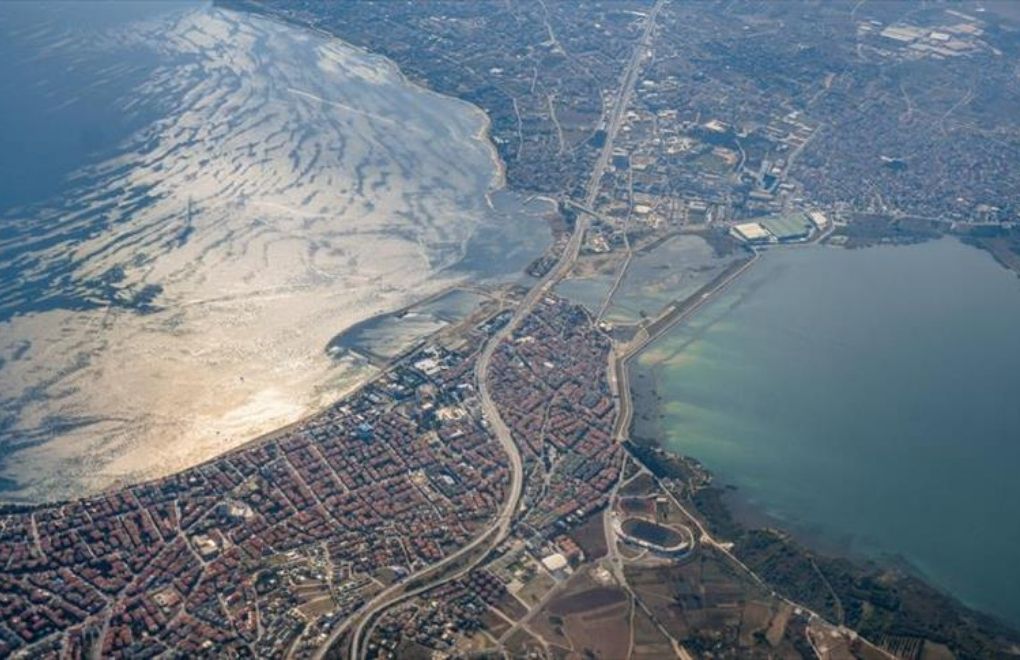
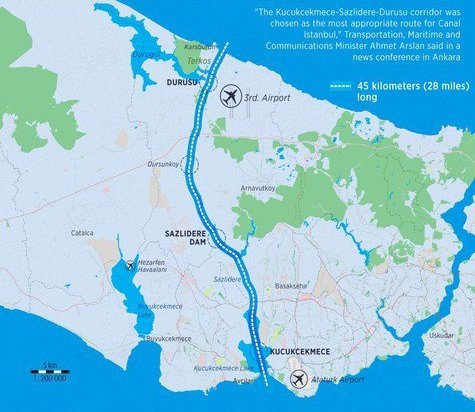
-132.jpg)

